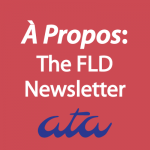
 To make our Continuing Education Series Podcast more accessible and searchable for FLD members and the general public, we are now offering transcriptions of our episodes right here on À Propos. Many thanks to our volunteer transcriptionists, who are credited at the bottom of each transcription. If you’re interested in helping us transcribe podcast episodes, email divisionFLD [at] atanet [dot] org.
To make our Continuing Education Series Podcast more accessible and searchable for FLD members and the general public, we are now offering transcriptions of our episodes right here on À Propos. Many thanks to our volunteer transcriptionists, who are credited at the bottom of each transcription. If you’re interested in helping us transcribe podcast episodes, email divisionFLD [at] atanet [dot] org.
HOW TO LISTEN TO THE ORIGINAL EPISODE
SOUNDCLOUD: You can listen to or download Episode 19 and all previous episodes on Soundcloud here.
ITUNES: This episode and all previous episodes are available on iTunes here. You can subscribe or listen online. Like what you hear? Rate us and review us! It really helps get the word out.
Episode 19: FLD’s ATA Certification Study Group
Andie: This is Andie Ho, your new host of the Continuing Education Series, a podcast we produce as a benefit to the members of the French Language Division of the American Translators Association, and for anyone interested becoming members. This series strives to offer educational content about the craft of French-to-English and English-to-French translation, and about our division. For today’s episode, it is my pleasure to welcome Emily Moorlach. Emily is an ATA-certified French-to-English translator who began her career in 2016 as the Translation and Interpretation Program Manager and freelance official document translator for a nonprofit organization. In 2019, after a whirlwind trip through 45 cities in Europe, Emily returned to the US, and started her freelance translation business, Langue Vivante LLC. She holds a BA in French and a BS in Accounting from Iowa State University.
Emily also studied at La Sorbonne in Paris and has held positions as a high school French teacher and a luxury travel advisor. I need to hear more about that sometime. Her main specializations include official documents, business communications, tourism, gastronomy, and marketing. Welcome, Emily, to our podcast today.
Emily: Thanks, Andie. It’s awesome to be here.
Andie: So today, we’re going to talk about the FLD’s ATA Exam Certification Study Group. We need a better title for that group, I think, Emily.
Emily: It’s very long,
Andie: So, start from the beginning. How did you get started as the study group’s coordinator?
Emily: Well, I think you know better than anyone, but I’ll let you know for the listeners here. So, I actually started my exam studying journey back in 2019, at the end of 2019, and I reached out to Corinne McKay via email and said: “Hey, do you know anyone else who’s studying for the exam? Can you kind of hook me up with someone?” Because I wanted someone to work with. She actually sent me your email and Beth’s. And I remember just reaching out, and kind of seeing what was available then. And we didn’t have a program like we do now. So, I just kind of started studying on my own. And then, in 2021, in January, you started this, the FLD study group. And I saw that as a great opportunity to really get serious about my studying after having to put it on hold in 2020. I saw 2021 as my year, and this new program was amazing. So, I jumped on and started doing it each month. Doing big passages each month. And I think over time, you saw that I was very serious about the study program and participated each of the months from January through September, before taking the exam myself. And, yeah, then at the end of the year, you asked me to come on as the new coordinator. And, because I had found the group so helpful, and probably because I was a previous teacher and I love the nerdy aspects of studying and constantly improving, I decided to take it over. So, I did that in January 2022, and it’s been great so far.
Andie: So, for those people listening who don’t know what the study group is like, exactly how it operates and what it does, can you describe it for us?
Emily: Yeah, so I have kept kind of the same structure that you instituted in 2021 with sending out a passage, the first business day of each month in each direction. So, French to English and one for English to French. I select those passages on new sites like the New York Times, National Geographic, The MOON, etc. the first business day of each month. I send out the new passage in each direction and participants can decide whether or not they even want to participate that month. If they do, they just translate it on their own time and send me an email by the third Monday of the month to let me know that they have completed it.
Then, I pair them up with another person who has completed it in the same direction, and then they have the rest of the month, which is usually a week or two, to exchange passages via email and kind of give each other feedback either via track changes in Word or phone call, video call, any of the above. Let’s see, then, what else? Yeah, I think that’s pretty much it. I send out the passage, then I pair participants up and then they kind of work together in groups of two or three to provide feedback.
Andie: So, you say that you mostly kept the model that I had used while you were a “student” in the group, quote unquote, student participants in the group. Do you foresee making any updates in the future?
Emily: Potentially, yes. I participated in a panel with the Spanish Language Division and also the Slavic Language Division, and they both have some great ideas that they use for their study groups, that I would kind of like to see how they would fit within ours as well. Potentially using Google Docs to compare all of the translations that have been completed for a language pair for that month. I think that would be great to see nine different translations side by side in a spreadsheet as the Spanish Language Division does. So even if you’re paired with a partner and having a deeper conversation one-on-one, you can see how many different ways a word can be translated and it kind of reveals the creativity of our craft. And it helps, yeah, I think, just gain different perspectives on how to approach a text.
Andie: I like it. I wish I had thought of that. So, when you were a participant, how, in what ways was the study group helpful for you as someone looking to take the exam in the future?
Emily: I think it was super helpful just to know that there are other people out there, kind of going through the same thing and finding other colleagues who are as serious about not only studying but actually taking the exam. So, I think that was great to find kind of a group of people to do that with. And I loved the fact that our study group is very low commitment. It’s kind of open-ended, so you can get on our email list, and then you can participate in January and then not participate again until May, if you know, your schedule gets crazy, like we all know it does, being freelance translators. So, it’s really low commitment. I love that. And then, I just loved being able to collaborate with other colleagues and meet people within my language pairing.
Andie: What about the… So, the ATA offers official practice exams that you can spend money on. Did you ever do any of those?
Emily: Yes. Being kind of the nerd, like I said that I am. I did my first one at the end of 2019 when I just wasn’t even a full-time translator yet. Just kind of thinking that was the first step of getting in and getting clients. And I thought, naively, I’ll just take the practice test and then I’ll be ready to go. Well, I took the first one and did fairly decent. I think it’s 17 points you need to be able to pass the exam. I think that’s the maximum, and points are bad. For our listeners out there, who haven’t looked into it yet. You don’t want points. I think I got in the 20ish range, and they said, okay, you could probably pass if you study a little bit more.
Well, then I took the second. There are three in each direction, three French to English and three English to French official practice exams. So, I took the second one just to kind of see where I was at on that, and I didn’t do as well, so that kind of changed my perspective, and I decided to study a little bit longer. So, I think taking at least one official practice exam is really essential to not just jumping into the real thing. And then, if possible, taking two or all three is great because they’re different passages you’ll do differently from one to the other, potentially passing one, potentially failing the next one, and that gives you more data points to know if you’re ready for the real thing.
Andie: Now, you wrote an article for the ATA’s Savvy Newcomer blog, is that correct?
Emily: Yes, I’m a volunteer blog author and editor, so that been fun.
Andie: All right. So, I see you’ve written an article called “Taking and Preparing for ATA Online Certification Exam.” And in that article, you mentioned using DeepL, which is a machine translation, to check your translations. Can you tell us more about this?
Emily: Yeah, I think it’s kind of, some people might think it’s, what would you say, a controversial thing to say because obviously we don’t want to train ourselves to translate like a machine. But in my study journey, I found that not only did I participate in the FLD study group, but I studied outside of the study group on my own. And, not everybody is going to have the time to study as much as you may need to study or have the same schedule to match up and review passages together outside of the study group. And so, when I studied on my own, I wanted a way to kind of see, something to compare my translations. And so, it was a free option. I used the free version.
I think with news articles and different types of text, more technical, more straightforward text, I think machine translation has gotten pretty good. And so, yeah, I would just throw my source text that I translated on my phone into DeepL, and just see what it said. And surprisingly, sometimes it shows better words than I did, especially given the time crunch when you’re sitting there trying to stick within the 90 minutes of what you’re allotted for the passage on the real exam. When studying on my own, I stuck to those same things. And yeah, I found DeepL to be helpful, to just get some sort of feedback when I didn’t have a human to do that with.
Andie: Interesting, that’s not something I would have thought of. Machine translation is very controversial, as you say. I will say that a lot of it comes from human translations. So that’s why sometimes it does choose a good word. That’s my opinion exactly.
Emily: Exactly, I like the feature on DeepL that you can click on a word, and it will show you synonyms and things like that. So, yeah, I think it can be helpful.
Andie: Did you use it to check for style or just meaning or both?
Emily: Kind of both, because every now and then, there would be a meaning situation that I was like, oh, I thought that meant something slightly different. Or word choice. Yeah, a lot of word choice, because I am actually fairly new to the profession. Just started full time in 2020, so, and I actually didn’t have any formal training. I just have my bachelor’s degree in French and as you mentioned, I was a French high school teacher and luxury travel consultant before this. So, yeah, for me it was just a great way to choose my words and see, not really style, but make sure I’m getting everything correct in terms of meaning, too.
Andie: Going back to something you mentioned, you were talking about time management during the exam. Can you talk to us about that a little bit?
Emily: Yeah. One of my study partners that I ended up working with through the study group, Amber Combaud, she mentioned that she was only taking 75 minutes out of the total 90 offered for each passage, to do both her translation and her editing. And I thought that was crazy at first when she said that, I thought, oh my gosh, I’m pushing myself all the way through the 90 minutes and leaving myself about six minutes to do the editing. And that was not working well for me because the editing step, I think, is so crucial, both the bilingual editing to make sure you’ve got everything from the source, but also the monolingual editing for those commas, periods, and things like that, because each one of those can get you a point deduction out of those 17 points.
So, when she mentioned that, I thought, okay, I’m going to make myself a schedule. And so, I actually did make myself a schedule, and it was that I was only using 75 minutes per passage, and then the other 30 minutes of time was kind of at the beginning, choosing which of the three passages to translate on the exam. So, I took some time to do that and then whatever was left over at the end. I also took some time to do some stretching in between passages on the real exam, the three-hour exam. So, I wanted to build in time for stretching, time for restroom breaks, time to just stare at the wall if I needed to give my eyes a break. So, yeah, I made myself a little scheduled.
That is actually in the Savvy article that I wrote, which maybe we can post a link to with this recording. But it detailed everything I plan to do in terms of time management on the actual exam, and that helped me to feel more comfortable and less stressed about time.
Andie: Those are all good tips. Going back to what you said about editing being crucial, I just had to laugh because I always tell my husband, if you read my translation before I go back and edit it would look like I don’t speak French or English.
Emily: Editing is so vital, so important. And one of the other colleagues that I work with in the study group, he also was doing Italian to English and French to English exam preparations. And we found out how important it is to really have a great grasp of the target language, even almost more so than the source language sometimes, because it’s all the grammatical things and the situation and word choice and making it sound good and making it flow. Yeah, the editing stage is super important.
Andie: Now, since I took the exam in 2018, the ATA has come out with an online exam. Did you do the online version?
Emily: I did, yeah.
Andie: Okay, can you tell us about the online version and in person version?
Emily: Yeah, so the online version, I took it in September 2021, so a little less than a year ago. And what’s really exciting is even since then, they’ve now come out with an on-demand version of the online exam. So, you can sign up and take it at a time that works for you, which I think is really great for any of our members who live outside of the US. Because one of my study partners actually ended up having to take the exam. She’s in France, ended up having to take the exam from 6:00 p.m. to 9:00 p.m., her time, whereas it was 9:00 a.m. to noon for my time on the Pacific Coast here. So, having that on demand version is amazing.
But yeah, in terms of the differences between the online and in person, I would say obviously I didn’t take the in person, but I read up on it and actually contacted Caron Bailey as well as, the certification manager, to kind of ask some questions at one point. And I think what’s really great about the online exam is the fact that you don’t have to pay any travel expenses, whether that just be gas, which is really expensive right now, whether that be gas or hotel or flights. Back, before they offered the online exam, you had to physically go to the location. And for people who live outside of the US, it was even more expensive. So, I love that fact that there’s no travel expense. And another benefit is lack of stress. There’s just not the stress of having to drive anywhere.
Even if you’re in the same city, you’ve got a drive to the exam, find parking, for me, I just like to have everything as smooth and stress-free as possible. So, my closest exam location was going to be an hour away. And so, no hotel, but I’m just driving the hour and thinking, am I going to get in traffic? Or something like that? So, eliminating that was helpful and then being able to do it from the comfort of your own home, your ergonomic desk and chair, you can control, your lighting, your heating, those things are tiny, but for me, as kind of a control freak, I really found comfort in that.
And then the cons, I guess, would be, of the online exam would be just the fact that you have to make sure that your computer has all of the correct configuration prior to the exam, and then the onboarding process for the exam on the day of the exam. You need to be there about 20 minutes early, and sometimes it can take even longer. So, I know that some people get a little bit nervous while they’re kind of going through that onboarding process. Am I going to be late for my exam? But I think knowing that your exam time doesn’t start until you get into the passages themselves is very helpful. So even if your onboarding takes 30 minutes and your ten minutes over from what your start time was supposed to be for the exam, your exam time doesn’t start until you’re in seeing those passages.
So, I think that’s helpful to know. Yeah, I could go on and on.
Andie: Yeah, I feel so like I very much took the old version. I had to drive down into Houston and that was already considered very close to me. I guess ATA has come to the 21st century.
Emily: Yeah, very convenient now with the on demand. I mean, for me, the time was perfect, nine to noon. I couldn’t ask for a better time, but I’m sure that my colleague who did it at night, during dinner time and such, was wishing that they had that even just six months ago.
Andie: So, if you had to do it all over again, or if you were to give advice to someone who is starting to study for the exam now, what would you say?
Emily: I would say, kind of like first steps first, read up about it as much as you can. If you’re going into English, there’s an amazing 61-page guide on into English. What is it called? The Into English [Grading] Standards or something like that. But it’s a guide that’s 61 pages into English grading standards, and that’s a really great document to start kind of seeing what the exam graders are looking for in terms of grammar punctuation, what you should do with acronyms, style guides, things like that. So, any language into English. So, if you’re one of those amazing people who has two source languages or more, the guide is still great because it’s for all languages into English.
So, yeah, starting there, looking at all of the framework for standardized error markings, the explanation of error categories, the flow chart for error point decisions, all of those documents, reading through them so you understand how you will be graded. It is super important, I would say. And then, kind of taking that, the official practice exam, to see where you’re at and get feedback that way is a great next step. They do take sometimes eight weeks to come back. So, like I said, that’s a good early step just to gauge where you’re at before taking the exam and then joining a study group, of course, especially if you’re in our FLD. Now that we have that in place, I think that’s a great thing to do. I would definitely do that again if I were to have to study. But kind of one of the biggest things for me, I had no idea that people study for the exam for so long. Like I mentioned earlier, when I got started on my exam journey in 2019, I thought I’ll take one practice exam and then I’ll be good to go.
I’ll sign up for an exam and in three months I’ll be certified. But really, after participating in several panels, I’ve learned that the study window is basically six months to a year for a lot of people; especially a lot of people who are working full time in the profession and have a lot of clients already, keeping up with studying kind of is an extra thing to do. So, when you start thinking about getting certified, I would say setting aside those six to twelve months is a good idea.
Andie: All right, and then final question: if people want to join your study group, what do they do?
Emily: Yeah, they just email me. So, we can hopefully, maybe, wherever you post the podcast, include my email address as well. But, for those listening, it’s emily [at] langue-vivante [dot] com.
Andie: Alright. And you can also email divisionfld [at] atanet [dot] org or if you can find me online somewhere, Andie Ho, A-N-D-I-E H-O, it’s a very unique name, so you’ll find me somehow and I’ll point you in the right direction.
Well, thank you so much, Emily, for sharing your experience and for leading the new study group. You’re doing a great job. I’ve heard great things and we very much appreciate all that you do.
Emily: Thank you for picking me to do it and I have, yeah, I’ve really enjoyed it and interacting with all of the people who are studying and kind of encouraging them on their journey because, yeah, I really enjoy the group as well.
Andie: Well, thank you very much.
Emily: Thank you.
Andie: This concludes our episode for today. You can subscribe to the Continuing Education Series podcast on SoundCloud at soundcloud@soundcloud.com/ata-fld) or on iTunes, by searching for Continuing Education Series in the iTunes store. You can contact the FLD at divisionfld [at] atanet [dot] org, visit our website at www.ata-divisions.org/fld or get in touch with us on social media.
This is Andie Ho, signing off. Thanks for listening and à bientôt!
Emily Moorlach is an ATA-certified French to English translator who began her career in 2016 as the Translation and Interpretation Program Manager and freelance official document translator for a nonprofit organization. In 2019, after a whirlwind trip through 45 cities in Europe, Emily returned to the U.S. to start her freelance translation business, Langue Vivante LLC. She holds a B.A. in French and a B.S. in Accounting from Iowa State University. Emily also studied at La Sorbonne in Paris and has held positions as a high school French teacher and luxury travel advisor. Her main specializations include official documents, corporate communications, and tourism industry materials. For more information, visit www.langue-vivante.com.
ATA Podcast host Andie Ho is a certified French to English translator specializing in the food industry. She earned her M.A. in translation from Kent State University and is now based in the Houston area. She currently serves as the ATA’s French Language Division administrator. You can follow her on Twitter at @JHawkTranslator or email her at andie [at] andiehotranslations [dot] com.
Transcribed by Olga Koloko. She is a French-to-English and English-to-French translator, editor, and transcriptionist who specializes in international development, business communications, marketing, IT, finance, internet policies, and digital rights. She is the founder and CEO of OK Translation and Communications Services LLC. You can find her on LinkedIn at https://www.linkedin.com/in/




 Isabelle Meurville
Isabelle Meurville








